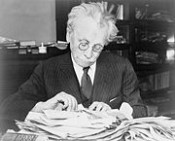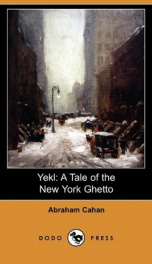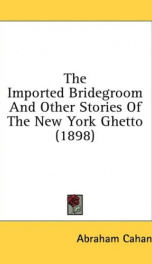Cahan Abraham

Abraham Cahan (1860—1951) was a Lithuanian-born American socialist newspaper editor, novelist, and politician. Abraham Cahan was born July 7, 1860 in Podberezhye, Lithuania, into a Orthodox Jewish family. His grandfather was a rabbi in Vidz, Vitebsk, his father a teacher of Hebrew and the Talmud. The family, which was devoutly religious, moved in 1866 to Wilna (Vilnius) where the young Cahan received the usual Jewish preparatory education for the rabbinate. He, however, was attracted by secular knowledge and clandestinely studied the Russian language, ultimately prevailing on his parents to allow him to enter the Teachers Institute of Wilna, from which he was graduated in 1881. He was appointed teacher in a Jewish government school in Velizh, Vitebsk, in the same year. On March 13, 1881, Tsar Alexander II was assassinated by terrorist members of the Socialist Revolutionary Party. Reprisals by the Russian state were quick and massive. A visit from the police prompted the young socialist schoolteacher to escape to the United States through emigration. Cahan arrived in New York City in June 1882. Cahan transferred his commitment to socialism to his new country, and he devoted all the time he could spare from work and study radical ideas among the Jewish working men of New York. Cahan joined the Socialist Labor Party of America writing articles on socialism and science, and translating literary works for the pages of its Yiddish language paper, the Arbeiter Zeitung ("Workers' News").[1] Cahan saw himself as an educator and enlightener of the impoverished Jewish working class of the city, "meeting them on their own ground and in their own language."[2] Cahan's contribution to Yiddish-language socialist propaganda was massive, as before his arrival educated Jewish émigrés from the old Russian empire tended to speak Russian. Historian Gerald Sorin notes: "As early as the summer of 1882, however, Abraham Cahan, in the United States only a very short time, challenged the Russian-speakers by pointing out that the Jewish workers did not understand the propaganda that the intellectuals were disseminating. It was proposed, almost as a lark, that Cahan lecture in Yiddish; and relatively quickly this so-called folk vernacular became the primary medium of communication. For some time, however, the consensus continued to be that Yiddish was strictly an expedient in the conduct of socialist activitiy and not a value in itself."[3] During his years of activity, Cahan was either originator, collaborator, or editor of almost all the earlier socialist periodicals published in that language in the United States. From 1903 until 1946, Cahan ran the Jewish Daily Forward (Forverts), a socialist Yiddish-language daily in New York. In 1906 he introduced an advice column named A Bintel Brief. As a rule, Cahan was one of the more temperate voices in the Socialist Party of America, respecting his readers' religious beliefs and preaching an increasingly moderate version of the socialist gospel as time progressed.[4] By 1924 Forverts had over a quarter of a million readers, making it the most successful non-English-language newspaper in the U.S. and the leading Yiddish paper in the world. Cahan quickly mastered the English language, and four years after his arrival in New York taught immigrants in one of the evening schools. Later he began to contribute articles to the Sun and other newspapers printed in English, and was for several years employed in a literary capacity by the Commercial Advertiser, where we was a regular contributor. While his Yiddish writings are mostly confined to propaganda, his literary work in English is mainly descriptive; and he has few, if any, equals in the United States in depicting the life of the so-called "ghetto," where he lived and worked for more than 20 years. Cahan is regarded as having been one of America's preeminent Yiddish novelists, a language which was previously regarded as a somewhat uncultured jargon of the common folk. His first novel, Yekl: A Tale of the New York Ghetto, was published in 1896. (In 1975 it would be released as the film, Hester Street). The graphic story of an Americanized Russo-Jewish immigrant, it attracted much attention and was favorably commented on by the press both in America and in England. W. D. Howells compared Cahan's work to that of Stephen Crane, and prophesied for him a successful literary future (The World, New York, July 26, 1896). Cahan's next work of fiction, The Imported Bridegroom, and Other Stories, published in 1898, was also well received and favorably noticed by the general press. Of his shorter publications, the article on the Russian Jews in the United States, which appeared in the Atlantic Monthly, July, 1898, deserves to be specially mentioned. His other important work, The Rise of David Levinsky, was published in 1917. Cahan also wrote a 5-volume Yiddish-language autobiography, Bleter fun mayn Leben, the first three volumes of which were translated into English as The Education of Abraham Cahan. Cahan died on August 31, 1951.
do you like this author?
What readers are saying
What do you think? Write your own comment on this book!
write a commentWhat readers are saying
What do you think? Write your own comment on this author!
write a commentBook list

The White Terror and The RedA novel of revolutionary Russia
Series:
Unknown
Year:
Unknown
Raiting:
3.5/5
Show more
add to favoritesadd In favorites

yekl a tale of the new york ghetto
Series:
Unknown
Year:
Unknown
Raiting:
4.5/5
Abraham Cahan (1860-1951) was a Russian-American novelist and labor leader. His family, which was devoutly Orthodox, moved in 1866 to Wilna; there young Cahan received the usual Jewish preparatory education for the rabbinate. He, however, was attracted by secular knowledge and clandestinely studied the Russian language, ultimately prevailing on his parents to allow him to enter the Teachers Institute of Wilna, from which he was graduated in 1881. He was appointed teacher in a Jewish government school in Velizh, Vitebsk, in the same year; but a domiciliary visit by the police, resulting from his connection with the revolutionary movement, caused him to flee the country. In 1882 he emigrated to the United States to escape the mass roundups of revolutionaries following the assassination of Russia's Tsar Alexander II. He was the founder-editor of the Yiddish newspaper, Forverts. A Providential Match was the first of Cahan's tales to be published, in 1895. His first novel was Yekl: A Tale of the New York Ghetto (1896). His next work of fiction was, The Imported Bridegroom, and Other Stories (1898). Another important work, The Rise of David Levinsky was published in 1917.
Show more
add to favoritesadd In favorites
Book list

The White Terror and The RedA novel of revolutionary Russia
Series:
Unknown
Year:
Unknown
Raiting:
3.5/5
Show more
add to favoritesadd In favorites

yekl a tale of the new york ghetto
Series:
Unknown
Year:
Unknown
Raiting:
4.5/5
Abraham Cahan (1860-1951) was a Russian-American novelist and labor leader. His family, which was devoutly Orthodox, moved in 1866 to Wilna; there young Cahan received the usual Jewish preparatory education for the rabbinate. He, however, was attracted by secular knowledge and clandestinely studied the Russian language, ultimately prevailing on his parents to allow him to enter the Teachers Institute of Wilna, from which he was graduated in 1881. He was appointed teacher in a Jewish government school in Velizh, Vitebsk, in the same year; but a domiciliary visit by the police, resulting from his connection with the revolutionary movement, caused him to flee the country. In 1882 he emigrated to the United States to escape the mass roundups of revolutionaries following the assassination of Russia's Tsar Alexander II. He was the founder-editor of the Yiddish newspaper, Forverts. A Providential Match was the first of Cahan's tales to be published, in 1895. His first novel was Yekl: A Tale of the New York Ghetto (1896). His next work of fiction was, The Imported Bridegroom, and Other Stories (1898). Another important work, The Rise of David Levinsky was published in 1917.
Show more
add to favoritesadd In favorites

the white terror and the red a novel of revolutionary russia
Series:
Unknown
Year:
Unknown
Raiting:
2.5/5
Show more
add to favoritesadd In favorites

the imported bridegroom and other stories of the new york ghetto
Series:
Unknown
Year:
Unknown
Raiting:
1.5/5
A collection of short works follows the adventures of Jewish immigrants who come to the New World in search of the promised land and instead find lives of grinding poverty, grueling work days, and challenges to their traditional values. Reprint. --This text refers to an out of print or unavailable edition of this title.
Show more
add to favoritesadd In favorites
What readers are saying
What do you think? Write your own comment on this author!
write a commentif you like Cahan Abraham try:
readers also enjoyed
What readers are saying
What do you think? Write your own comment on this author!
write a commentGenre
if you like Cahan Abraham try:
readers also enjoyed
Do you want to exchange books? It’s EASY!
Get registered and find other users who want to give their favourite books to good hands!

